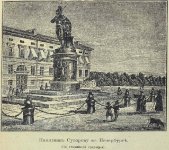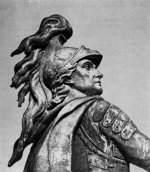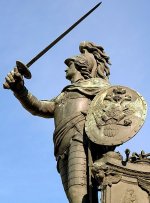We keep on running into various 18th-19th century individuals whose monuments remind everybody of the Roman Empire. The Western Empire fell (officially that is) circa 476 AD. The Holy Roman Empire was dissolved in 1806, but the attire style depicted on those monuments is clearly very very old.
The monuments, if we follow out traditional chronology, were built over a thousand years later. Where was this infatuation with the Roman Empire coming from? May be there was no thousand+ years between those 18th, and 19th century monuments, and the actual time the Empire existed.
Who of the historical individuals officially pertaining to the 18th, or 19th century had a roman looking monument dedicated to him?
I was gonna start with Napoleon, but ran into this Suvorov guy, so he is going to be the topic starter.
The monument was installed in 1801.
KD: I have two possible explanations.
The monuments, if we follow out traditional chronology, were built over a thousand years later. Where was this infatuation with the Roman Empire coming from? May be there was no thousand+ years between those 18th, and 19th century monuments, and the actual time the Empire existed.
Who of the historical individuals officially pertaining to the 18th, or 19th century had a roman looking monument dedicated to him?
I was gonna start with Napoleon, but ran into this Suvorov guy, so he is going to be the topic starter.
Alexander Suvorov
Alexander Vasilyevich Suvorov (1729 or 1730 - 1800) was a Russian military leader, considered a national hero. He was the Count of Rymnik, Count of the Holy Roman Empire, Prince of Italy, and the last Generalissimo of the Russian Empire. (so much for being Russian I guess).The monument was installed in 1801.
KD: I have two possible explanations.
- These monuments used to be dedicated to some totally different individuals. We simply put a different tag on them.
- The paintings were made up later, and the statues depicted the actual individuals.




